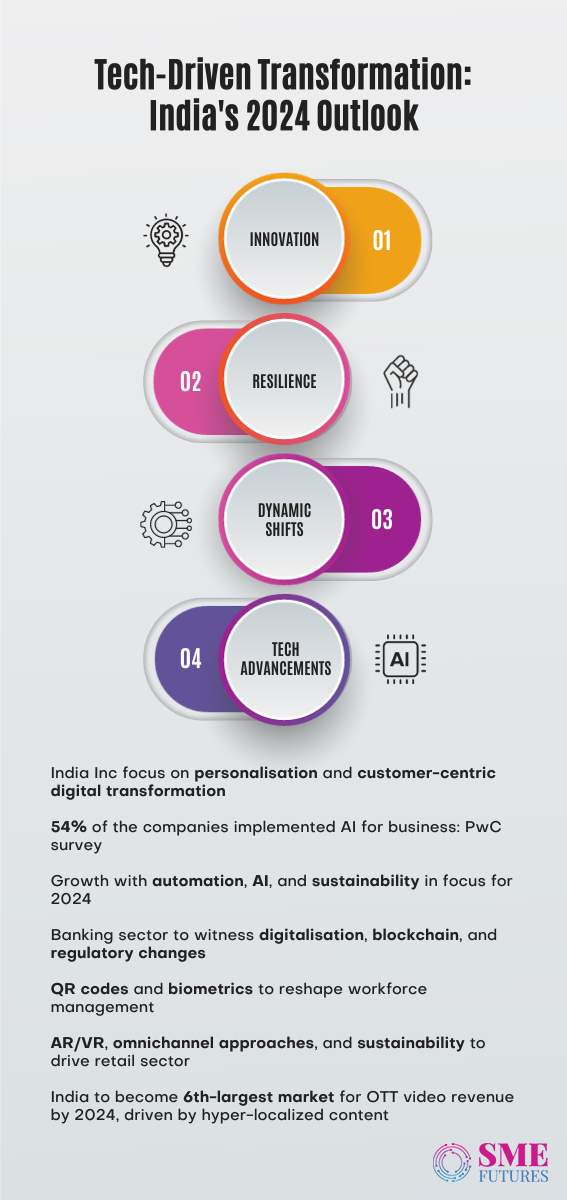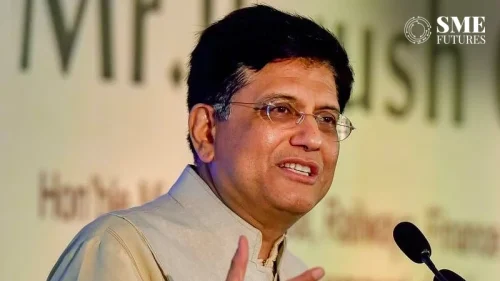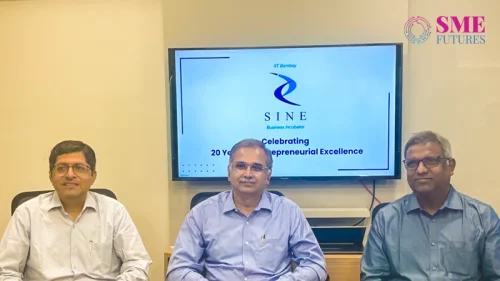As we stand on the brink of a new year, the corridors of India’s economic sectors are echoing with anticipations of growth, innovation, and adaptability. In the intricate web of industries that make up the nation’s economic landscape, 2024 is projected to be a year of significant shifts, guided by technological advancements, regulatory reforms, and the ever-evolving needs of consumers. Let’s understand how stakeholders from different sectors foresee how these trends will pan out.
Transformative growth for manufacturing sector
The Manufacturing Index or the Manufacturing PMI decreased to 55.50 points in October from 57.50 points in September 2023. However, manufacturers predict transformative growth for India’s manufacturing sector in 2024.
According to the stakeholders, the sector is poised for a paradigm shift towards advanced manufacturing technologies, driven by automation, artificial intelligence, and data analytics.
Vikas Kumar Mittal, Managing Director, Nova Formworks says, “In 2024, automation and AI will play pivotal roles, enhancing efficiency and precision in production processes. Smart factories, equipped with interconnected devices and sensors, will enable real-time monitoring and control, optimizing resource utilisation.”
Jay Deepak Shah, CEO of Jay Wood Industry adds, “Sustainability takes centre stage, with JWI leading the way in sustainable practices within the pallet industry. For example, we use solar panels to power the manufacturing of wooden pallets, substantially reducing our carbon footprint. Collaborations, both within and beyond the industry, are emphasised to foster innovation, and the integration of digital platforms and smart technologies will play a pivotal role in optimising supply chain management.”
Also, the adoption of green manufacturing processes, powered by renewable energy sources, will contribute to reducing the sector’s environmental footprint. Circular economy principles will gain prominence, emphasising the reuse and recycling of materials.
Financial services companies will evolve with technology
In 2024, the banking sector is poised for transformative advancements driven by technological innovation, evolving customer expectations, and regulatory changes. The industry’s landscape is rapidly shifting towards digitalisation, redefining traditional banking processes and creating new opportunities for efficiency and customer-centric services.
Soumya Sarkar, Co-Founder of Wealth Redefine, notes the banking sector’s tech adoption (e.g., mobile banking, UPI) and the insurance industry’s growth through diversified products and improved customer service due to regulatory changes. Mutual funds, now a Rs. 40-lakh crore industry are demonstrating investor preference for professionally managed portfolios. The rise in investor education is enhancing informed decision-making.
According to Vaibhav Tambe, Founder & CEO, TransBnk, a key trend is the widespread adoption of blockchain technology. Distributed ledger systems improve transparency, security, and transaction speed, reducing reliance on intermediaries and minimising fraud risk.
“Blockchain-powered smart contracts automate complex transactions, optimising operational workflows for both banks and clients. The rise of APIs fosters greater connectivity and collaboration within the financial ecosystem. Open banking initiatives break down traditional silos, enabling banks to offer more personalised and integrated services, enhancing the customer experience. Regulatory advancements, including the development of central bank digital currencies (CBDCs) and refined know your customer (KYC) processes, contribute to a more secure and compliant transaction environment,” he contends.
Akshar Shah, Founder at Fixed Invest says that in 2024, there will be more focus on paperless banking and paperless investments across asset classes. “We are also seeing a huge trend and shift towards marketplace models in banking and BFSI. Customers want to evaluate different banks before making their choices and this is set to be one of the prominent themes for digital adoption in 2024,” he avers.
However, there are challenges like cybersecurity threats and regulatory complexities as well. “I feel that these challenges will unveil opportunities for fintech companies to innovate, ensuring financial services’ accessibility and efficiency. The regulatory reforms led by SEBI, IRDAI, and RBI have instilled investor confidence, contributing to the sector’s robust growth,” says Sarkar.
Automation’s impact on workforce
Automation, spearheaded by technologies like QR codes, RFID, and Biometrics, is revolutionising workforce management.
JP Mishra, Country Manager India at Newland AIDC says that this shift has significantly increased productivity, efficiency, and safety across various industries, allowing companies to produce more with fewer resources and lower labour costs.
Mishra references a recent BCG study which highlights that standardising workforce management procedures can increase workers’ availability in the field by 50 per cent and reduce routine job times by 25 per cent.
“As we journey into 2024, the overarching theme is clear: automation isn’t just a mere mechanism but a dynamic ecosystem where AI, ML, collaborative robots, and RPAs will converge to shape the future. The evolution of automation systems, coupled with these transformative technologies, promises a landscape where efficiency and adaptability will be the doorways to new possibilities and redefine the way we work and interact with technology,” he says.
Mishra further stresses the importance of a culture of adaptability and lifelong learning, particularly given the challenges posed by an aging population. He underscores the significance of STEM skills for the workforce, essential for securing high-tech jobs arising from the increasing integration of AI and automation.

Automation’s impact on mobility
We predict a substantial transformation in the mobility sector by 2024. The integration of cutting-edge technologies is set to reshape how we perceive and experience transportation. This convergence not only promises increased efficiency and convenience but also contributes to the narrative of sustainable and interconnected urban living.
Narayan Mishra, Co-Founder & CTO, Tummoc, a public transit app agrees that the automation sector is increasingly intertwined with mobility solutions, fostering innovation in areas like autonomous vehicles, smart infrastructure, and seamless connectivity. “This symbiotic relationship has the potential to revolutionise how we move, addressing challenges related to congestion, environmental impact, and accessibility,” he asserts.
“In the upcoming years, we envision a dynamic shift in orchestrating mobility, with automation playing a pivotal role in creating smarter, more efficient transportation systems. As the industry embraces these advancements, it aligns with the broader goal of developing inclusive, technology-driven solutions that enhance the quality of life of communities nationwide,” he adds.
Technology is transforming retail
In the wake of record-breaking Diwali sales, India’s retail sector, boasted a staggering trade of Rs 3.75 lakh crores. The festive season propelled automobile retail sales to an all-time high of 3.793 million units, marking a remarkable 19 per cent increase in 2023. Simultaneously, online retail shattered records, underscoring the transformative power of technology in the retail landscape.
Chirag Taneja, Co-Founder and CEO at GoKwik, asserts that 2023 showcased the enduring strength of e-retail, with digital-first brands like Mamaearth making its IPO. As we step into 2024, the retail sector stands on the cusp of significant transformation, driven by technological innovations and evolving consumer preferences.
Avanish Agarwal, Consulting CMO at SMAAASH says, “The integration of augmented reality (AR) and virtual reality (VR) technologies is expected to enhance the in-store shopping experience. Retailers are likely to leverage AR to provide interactive product displays, allowing customers to visualise products in real-world settings before making a purchase.”
Personalised shopping experiences, fuelled by artificial intelligence (AI) and machine learning (ML) algorithms, will gain prominence, tailoring recommendations based on individual customer preferences and behaviours, he adds.
Taneja underscores the enduring importance of customer experience, as e-commerce brands strive to deliver fast, personalised, and secure shopping experiences. “With 60 per cent of global shoppers favouring online over in-store shopping, a notable trend in 2024 will be the shift towards an omnichannel approach. Digital-first brands will extend their presence beyond the online realm, integrating offline touchpoints for seamless shopping experiences,” he says.
Concurrently, physical retail outlets will embark on a digital transformation journey, recognising the need for a robust online presence. By leveraging technology and AI, e-commerce brands will provide tailored experiences, optimise checkout processes, and ensure profit margins continue to grow, addressing challenges unique to the cash-driven Indian landscape.
Furthermore, sustainability and eco-consciousness are anticipated to shape the retail landscape, with consumers prioritising environmentally friendly products and ethical business practices. Retailers are expected to adopt sustainable practices throughout their supply chains and emphasise eco-friendly initiatives as integral parts of their branding strategies.
Cloud gaming in 2024
In the gaming sector, cloud gaming is anticipated to gain momentum, enabling users to play high-quality games on various devices without the need for powerful hardware.
Agarwal of SMAAASH says that this shift towards cloud gaming is likely to reshape the traditional gaming console market and foster the development of subscription-based gaming services.
“Additionally, the metaverse concept is expected to influence the gaming industry, creating immersive and interconnected virtual spaces where users can socialize, work, and play. Smaaash is embracing this new tech with open arms, and we are already experimenting with the metaverse concept and are set to launch new concept experiences by mid 2024,” he says.
Both industries will also witness a rise in the use of blockchain technology for enhanced security and transparency, particularly in payment systems and digital asset management. Overall, the convergence of technology, sustainability, and immersive experiences will define the retail and gaming sectors in 2024.
OTT space to grow with technology
According to PwC’s projections, India is poised to become the sixth-largest market in the world for OTT video revenue by 2024, underlining the tremendous growth potential in this sector.
Kaushik Das, Founder and CEO of AAONXT, East India’s OTT platform, predicts a surge in demand for hyper-localised content, providing a unique and personalised viewing experience.
“This shift aligns seamlessly with AAONXT’s core mission of curating original and indigenous regional Odia content. Furthermore, within the OTT space, trends are likely to witness an increased focus on interactive and immersive experiences, leveraging emerging technologies such as AI/ML and the metaverse,” he says.
Furthermore, the convergence of technology and content creation opens new avenues, and we are excited to explore innovative narratives and formats that cater to the evolving preferences of audiences, he adds.
According to him the industry is witnessing a significant shift towards diverse and gripping narratives that transcend geographical boundaries.
“As content creators, our focus at AAONXT remains steadfast on delivering high-quality, authentic storytelling that resonates with audiences of all age groups. We understand the importance of contributing to the vibrant cultural expression of Eastern India and beyond, making our mark in the global entertainment landscape. The future promises exciting possibilities, and we are committed to being a driving force in shaping the narrative of content consumption in the years to come,” he asserts.











